Let’s talk museums. Not the artsy kind we so often cover. Not the Smithsonian Institution’s many museums in Washington, or the Metropolitan Museum of Art in New York.
I’m talking strange museums.
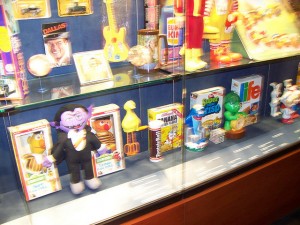
There’s a museum for just about everything, all right. This photo was taken at Geppi’s Entertainment Museum in Baltimore, Maryland. It tells the story of American pop culture going back a couple of centuries. (Spike55151, Flickr Creative Commons)
You see, Americans may be unique in saving and displaying all kinds of unusual, even useless, items in tiny collections devoted to just one subject. Somewhere in America, for instance, you’ll find a salt museum, an oyster museum, and museums devoted to nothing but bedrooms, vacuum cleaners, popcorn poppers, pretzels, mushrooms, and trumpets! We love these places.
And I’d have told you all about a truly unusual museum in Minneapolis, Minnesota, except that its founder and driving force, Robert McCoy, died in May. Much of his collection was moved to a bigger museum across the Mississippi River in St. Paul.
McCoy’s pride and joy was his free, hands-on “Museum of Questionable Medical Devices” — a big room full of gadgets and dials and blinking lights. It was all financed by his wife, Margaret, a practicing physician. All of the items were once advertised as magic cures for what ails us, from flat feet to blood pressure to cancer. Some even claimed to regenerate missing organs!
What these gizmos had in common is that . . . they didn’t work! Most were complete frauds, scams, hoaxes, designed to separate the desperate and gullible from their money.
Bob McCoy was once a salesman himself. He sold steel products throughout the Midwest. He was also a lifelong skeptic who began to collect some bizarre, fake medical machines to expose the trickery of quacks, faith healers, and con men. The American Medical Association and the government’s Food and Drug Administration even loaned him some fraudulent devices from their collections.
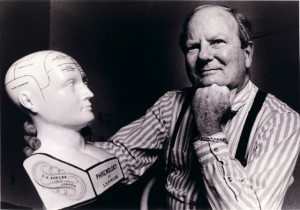
Here’s Bob with one of his favorite props — L.N. Fowler’s china model showing people’s “phrenology faculties.” (www.museumofquackery.com)
McCoy had several “phrenology machines” such as the “Psychograph,” which supposedly “read” the bumps on people’s heads and rated the individuals in categories such as “sexamity” and “suavity.”
McCoy once took a phrenology device onto television’s “Tonight Show,” where host Johnny Carson stuck a pineapple into a phrenology-reader box. After all the bells and whistles had finished, the machine gave the pineapple a printed personality rating.
Called it “prickly,” perhaps.
These machines were generally harmless — more of a curiosity than a device used to defraud people. In fact, Psychograph readings were popular in movie-theater lobbies and department stores in the 1930s.
According to McCoy’s museum Web site, called the “Museum of Quackery,” the Psychograph consisted of 1,954 parts in a metal carrier with a continuous motor-driven belt inside a walnut cabinet containing statements about 32 mental faculties. “These faculties were each rated 1 through 5 — ‘deficient’ to ‘very superior,’” McCoy told me. “So there were almost unlimited numbers of possible combinations.”
One’s “score” was determined by the way the 32 probes, each with five contact points in the headpiece, made contact with the head. The subject sat in a chair connected to the machine, and the headpiece was lowered and adjusted. The operator then pulled back a lever that activated the belt-driven motor, which then received low-voltage signals from the headpiece and stamped out the appropriate statement for each faculty consecutively.
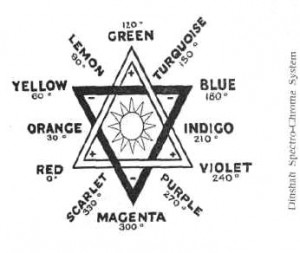
Other devices weren’t so benign. One, for instance, was called a “Spectro-chrome.” It had a 1,000-watt lighthouse bulb — a humdinger of a light — inside a box. A patient sat in front of it, IN THE NUDE, facing north, and then flipped on the light, which was covered by colored filters. Red was good for heart problems, blue for sexual impotence, and so forth.
The “healer” sold more than 10,000 of these at $150 apiece — big money 70 years ago.
The boom in phony medical machines peaked in the 1920s and ’30s, when mysterious forces such as radio waves, radioactivity, and neon were first introduced. Some of the fraudulent devices that Bob McCoy displayed included a chair that severely vibrated a patient — really shook him up — with the aim or keeping his bathroom visits regular.
One of these chairs was in use in the gymnasium of the British ocean liner Lusitania, sunk by German U-boats during World War I.
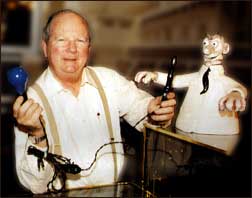
Bob McCoy explains a device that employs electrodes to increase virility and “cure” prostate problems. Ouch! (www.museumofquackery.com)
Bob McCoy’s son, Bruce, who once helped his father administer phrenology “readings” to visitors at the Museum of Questionable Devices, told me that his dad was born and reared in the capital of American skepticism: the “Show Me” state of Missouri.
“He had his eccentricities, yes,” Bruce said. “He was a jolly fellow, a humanist and storyteller who enjoyed putting on a show. But he was deadly serious when it came to exposing quackery. He saw that people all too readily believed in supernatural powers. In the face of obvious deceptions, they believed anyway, mostly because they wanted to.”
His dad “believed that nonsense was a dangerous thing,” Bruce McCoy told the Minneapolis Star-Tribune.
When I met Bob McCoy in Minneapolis 10 years ago or so, he told me that the American Medical Association considered a Dr. Albert Abrams the “King of Quacks.” Abrams got people all over the country to send in drops of their blood, along with quite a few dollars.
“He put the drops of blood in a machine and had his chauffer stand on a plate that was connected to it,” McCoy explained. “By thumping on the chauffer’s stomach, he could tell what was wrong with the person who sent the drops of blood in. After he fiddled around with these numbers and so forth, he diagnosed everybody who sent the blood sample in as having cancer and syphilis.
“But he had a cure for only a hundred dollars.”
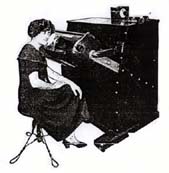
Here’s a classic: This enormous “Tricho Machine,” installed in many beauty parlors across the country, used “direct x-rays” focused on the cheeks and upper lips of woman who wanted to permanently remove superfluous hair. (www.museumofquackery.com)
At various points around the floor of the Museum of Questionable Devices — and presumably, to a lesser extent, at the new location at the Science Museum of Minnesota in St. Paul — were fantastic-looking objects that purported to use “magical” radio waves to cure disease. In some cases, the quack would offer to use these radio waves to treat patients thousands of kilometers away.
McCoy once took apart an incredibly elaborate machine called an “Electrometabograph,” weighing more than 200 kg and covered with dials and meters. It was supposed to cure conditions such as sensitivity to noise, numbness in the body — even nymphomania — using “silent radio waves,” all by pushing different buttons. Inside, the box was completely empty. Yet more than 40 manufacturers produced similar fancy wooden and metal “curative” cabinets.

Electrovita water was supposedly “impregnated with the essential mineral elements by ELECTROLYSIS” in order to give it properties that would improve digestion and “nerves.” (www.museumofquackery.com)
Even the respected Crosley Company — a radio pioneer and the maker of refrigerators, automobiles, and television sets — was tricked into making the “Exervac” machine to cure baldness. It’s a cabinet attached to a metal skull cap by a rubber hose.
And at least there was SOMETHING inside: an air compressor and a vacuum pump. Bob McCoy demonstrated it on himself for me. You’ll have to let his description explain what’s going on:
“Now when I turn this on (clicking noise and motor sound), the patient puts this thing over his head. Then the vacuum will begin sucking out those clogged pores in his head. And the people who made this believed that bald people really would have a full head of hair if you just cleaned out their pores.”
I looked at the monk-like fringe around his head and remarked that the procedure hadn’t done him a lot of good.
“Oh, to the contrary,” he said with a wink and a laugh. “I was completely bald until I used this!”
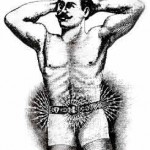
Most of Bob McCoy’s collection consisted of dusty, historical curiosities. But he asserted that the Information Age had only multiplied the scams by going after people with AIDS and cancer. Modern devices are just as empty and worthless as those of 70 years ago.
If you’re ever in the U.S. Upper Midwest, you can check out some of Bob McCoy’s collection of worthless medical devices at the Science Museum of Minnesota. That is, after you’ve investigated other Minnesota oddities, such as The Bakken, a Minneapolis museum devoted just to electricity and electromagnetism. There’ve been some phonies involved in that field, too.
Ted's Wild Words
These are a few words from this posting that you may not know. Each time, I'll tell you a little about them and also place them into a cumulative archive of "Ted's Wild Words" in the right-hand column of the home page. Just click on it there, and if there's another word that you'd like me to explain, just ask!
Gizmo. An all-purpose word that one can use to describe an object for which you don’t really have a name. Others are “whatchamacallit” and “doodad.”
Humdinger. A person or thing that’s really remarkable. The term was named after an exceptionally skilled American athlete and aviator, Arnold Humdinger. Skilled, except that he died trying to land his biplane on the summit of Mt. Everest.
Quack. A phony or incompetent medical practitioner who dispenses useless treatments and potions.
Scam. A fraudulent scheme or enterprise, designed to bilk unsuspecting “suckers” of their money.


2 responses to “Only in America: Quack, Quack!”
As bad as the Dems are, they represent the only thing protecting us from a complete takeover by these financial elites. It is not an irrelevanc-e to note that todays Wall St. cash is flowing far more strongly to the Rs than the Ds. Those who hope to correct this destructio-n of our democracy by the big money interests need to focus on getting the Rs out of Congress. With a moderate Republican (Obama) and an old money country club Republican (Romney) as our only two choices, it is Congress that holds the keys to our future as a country, not the president, whoever he may be.best diablo 3 gold
Dear Rachel,
I’m not sure what this comment has to do with anything I’ve written, but I find nothing objectionable in it, so have at it!
Ted